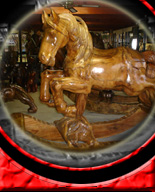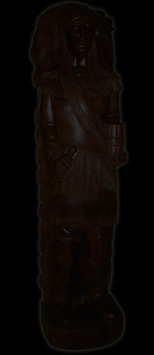


Over 200 wood carvings on display!!
The history of the Rocking Horse
Rocking horses date back to the 17th Century. King Charles I of England rode one of the earliest examples of a rocking horse when he was a young boy. His rocking horse survives to this day. Socrates is another great historical figure who galloped about with his children on their rocking horse while toy rocking horses have amused, trained and educated children of all ages for centuries. In the middle ages they served a serious purpose for budding knights who practiced jousting on wheeled horses. By the 1800's, rocking horses had changed to the traditional form replicated by today's artists. The Victorian style horse on bow rockers is considered the safest form because of the width of the rockers and resistance to being overturned. During the 19th Century1851 Queen Victoria visited the workshop of J.Collinson and sons. When asked to select a rocking horse she chose one painted dapple grey. After this visit the company produced only dapple greys. Migrating to the United States in 1885 William Long advised that he makes rocking horses "in the neatest manner".
In the late 1800's, several inventive rocking mechanisms sprang onto the market. One alternative rocking mechanism was the "swing iron safety stand" developed by P. J. Marqua of Cincinnati, Ohio, USA, and was patented in London in January 1880. The "safety glider" has the distinct advantage over the rocker in that it does not move across the floor and takes up less space for an equivalent size horse. Because of its safe design, the safety stand allows a longer swing and is used almost universally by makers today. Most of the factory produced wooden horses were gessoed and painted a characteristic dapple-grey. In 1878 a patent obtained by Philip Marqua in the United States covered his design of a swing stand for rocking horses. Two years later a letter of patent was granted to Herbert Haddon of London for the same device. English rocking horse makers quickly saw the potential for this design and by the late eighteenth century rocking horses were offered for sale mounted on either bow rockers or swing stands.
Rocking horses were enormously popular throughout Great Britain especially during Georgian and Victorian times. They also flourished in Germany and in America until the middle of the Twentieth Century, when production of fine wood rocking horses almost disappeared.
The first world war of 1914 to 1918 saw a decline in the manufacture of rocking horses due mainly to a shortage of materials and the skilled craftsmen required to make them. Fortunately for us, the rocking horse in all its glory has enjoyed a renewal in popularity during recent years and there are now several rocking horse makers around the world who are able to offer quality horses.
The last twenty years has seen a remarkable resurgence of this historical and much beloved toy. Today, antique wooden rocking horses have become collectors' items while new artists have emerged with their own personalized approach to this fine tradition. This wonderful rocking toy is now offered in every animal and vehicle imaginable! Additionally, it's offered in soft plush materials and poly resin plastics! Rocking horses (and other animals) are available at many different price levels - from the affordable, cute first ride-on toy, to the more expensive, works of art.
Rocking horses date back to the 17th Century. King Charles I of England rode one of the earliest examples of a rocking horse when he was a young boy. His rocking horse survives to this day. Socrates is another great historical figure who galloped about with his children on their rocking horse while toy rocking horses have amused, trained and educated children of all ages for centuries. In the middle ages they served a serious purpose for budding knights who practiced jousting on wheeled horses. By the 1800's, rocking horses had changed to the traditional form replicated by today's artists. The Victorian style horse on bow rockers is considered the safest form because of the width of the rockers and resistance to being overturned. During the 19th Century1851 Queen Victoria visited the workshop of J.Collinson and sons. When asked to select a rocking horse she chose one painted dapple grey. After this visit the company produced only dapple greys. Migrating to the United States in 1885 William Long advised that he makes rocking horses "in the neatest manner".
In the late 1800's, several inventive rocking mechanisms sprang onto the market. One alternative rocking mechanism was the "swing iron safety stand" developed by P. J. Marqua of Cincinnati, Ohio, USA, and was patented in London in January 1880. The "safety glider" has the distinct advantage over the rocker in that it does not move across the floor and takes up less space for an equivalent size horse. Because of its safe design, the safety stand allows a longer swing and is used almost universally by makers today. Most of the factory produced wooden horses were gessoed and painted a characteristic dapple-grey. In 1878 a patent obtained by Philip Marqua in the United States covered his design of a swing stand for rocking horses. Two years later a letter of patent was granted to Herbert Haddon of London for the same device. English rocking horse makers quickly saw the potential for this design and by the late eighteenth century rocking horses were offered for sale mounted on either bow rockers or swing stands.
Rocking horses were enormously popular throughout Great Britain especially during Georgian and Victorian times. They also flourished in Germany and in America until the middle of the Twentieth Century, when production of fine wood rocking horses almost disappeared.
The first world war of 1914 to 1918 saw a decline in the manufacture of rocking horses due mainly to a shortage of materials and the skilled craftsmen required to make them. Fortunately for us, the rocking horse in all its glory has enjoyed a renewal in popularity during recent years and there are now several rocking horse makers around the world who are able to offer quality horses.
The last twenty years has seen a remarkable resurgence of this historical and much beloved toy. Today, antique wooden rocking horses have become collectors' items while new artists have emerged with their own personalized approach to this fine tradition. This wonderful rocking toy is now offered in every animal and vehicle imaginable! Additionally, it's offered in soft plush materials and poly resin plastics! Rocking horses (and other animals) are available at many different price levels - from the affordable, cute first ride-on toy, to the more expensive, works of art.
Navigation     | |
 | |